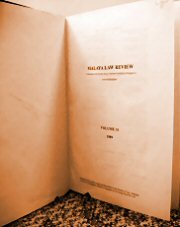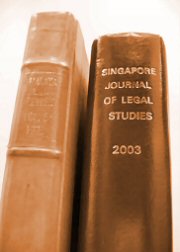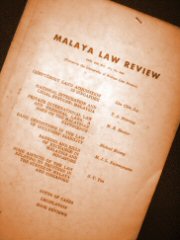|
Archive |
2386 records match your query:
| 351. | DECEMBER 2011 Issue | p.600 | |
| | Book Review: Dalhuisen on Transnational Comparative, Commercial, Financial and Trade Law by Jan Dalhuisen
Tey Tsun Hang • [2011] Sing JLS 600 (Dec)Not many writers in the diverse and very broad fields of transnational law are capable of integrating them into a clear, coherent and concise reading. The fourth edition of Dalhuisen on Transnational Comparative, Commercial, Financial and Trade Law continues to examine these bodies of law - from the formation of contracts in civil and common law to the private international law aspects of chattels and assignments, and from modern security interests to international aspects of financial services regulations - with its unique virtuosity in explanation, narration and presentation. Dalhuisen takes an international perspective on these various subjects, helping to locate domestic commercial and financial law in their wider context.
| | 352. | JULY 2011 Issue | p.1 | |
| | Women, Marriage and Motherhood in the United States: Allocating Responsibility in a Changing World
Martha Albertson Fineman • [2011] Sing JLS 1 (Jul)The lesson from the United States is that egalitarian law reform alone is inadequate to achieve gender equality, be it at home or in the workplace. Formal equality may be useful in defining some relations between adults, but family dynamics, as well as the realisation that state and market institutions must be responsive to human dependency and vulnerability, must also be factored into considerations of what is needed in the way of reforms. For example, merely encouraging egalitarian family policies has not resulted in significantly removing the obstacles to women's equal participation in the workplace when they become mothers. The State must also respond to the situation of women (and others) who are placed in vulnerable positions in the workplace because of the care work they perform in the family. A responsive State would pay attention to the operation and functioning of the institutions, entitlements and other mechanisms that provide the resources that individuals need in order to successfully undertake responsibility for those who are dependent in society, such as infants and children, as well as some elderly, disabled, or ill adults. It is time to expand our rhetoric of 'personal responsibility' to include a notion of 'shared responsibility', in which the state and market institutions are charged with ensuring that there is truly equality of access and opportunity. This would require the accommodation of our shared human vulnerability and dependency, as well as the undoing of institutional practices and relations that unduly privilege the circumstances of some workers while tolerating the structural disadvantages with which others grapple on a daily basis.
[Full Text]
| | 353. | JULY 2011 Issue | p.18 | |
| | Women in English Family Law: When Is Equality Equity?
Gillian Douglas • [2011] Sing JLS 18 (Jul)The principle that women are equal with men lies at the heart of their emancipation, and underpins the enactment of the Women's Charter of Singapore. But the question of how that equality is to be reflected in women's treatment under the law is more complicated. The device usually employed in the law is that of formal equality - on the face of the legislation, or in the case-law, women are to be regarded and assumed to be equal. But it does not follow from the principle that men and women should be treated as equal under the law, that their position in the wider society is in fact equal. This article examines two key aspects of English family law which exemplify the problem of the gap between formal and substantive equality for women: asset division on divorce and post-separation parenting.
| | 354. | JULY 2011 Issue | p.37 | |
| | Relatively Criminal: Spouses and the Criminal Process
Micahel Hor • [2011] Sing JLS 37 (Jul)This article explores the interface between family law and criminal law in the criminal process, in the contexts of the spouse as a witness and the spouse as a victim. It probes the question of whether the criminal law should retain or develop special rules or policies when the marital relationship is potentially affected by the operation of the criminal process, contrasting the decline of spousal 'exceptionalism' in the context of spousal witnesses with the apparent vigour exhibited in the official reluctance to enforce the criminal law in situations of minor spousal violence.
| | 355. | JULY 2011 Issue | p.61 | |
| | The Quest for Optimal State Intervention in Parenting Children: Navigating Within the Thick Grey Line
Debbie Ong Siew Ling • [2011] Sing JLS 61 (Jul)This article draws upon lawand social science research in examining the private and public spheres in parenting children. It argues for state intervention in cases where evidence of acts can be marked out with clear consensus as constituting abuse or ill-treatment. Beyond this, there is a substantially large area of uncertainty, a 'thick grey line', within which it is not always clear whether parents' behaviour should be regarded as abuse or ill-treatment. 'Better safe than sorry' is an inappropriate adage for supporting intervention in the 'thick grey line'. The law should guard against being overzealous in interfering in the parent and child relationship. Suggestions are made on reform of the statutory provisions on child protection as well as how the court may, under the current provisions, be guided to make appropriate orders in this area.
| | 356. | JULY 2011 Issue | p.89 | |
| | 'Matrimonial' Realty Under a Resulting Trust
Tan Yock Lin • [2011] Sing JLS 89 (Jul)Implicating a cross-section of property and familial policies, the question of when and whether a spouse acquires a resulting trust interest in realty jointly occupied with another spouse is one of the emotive questions of our times. This article examines the merits of a conventionalistic conception of the resulting trust against competing dogmatic and intentionalistic conceptions, and concludes that it furnishes a better resolution of the impinging policies. As the Court of Appeal decision in Lau Siew Kim is a foremost example of the conventionalistic analysis, attention is focused on various aspects of the decision with a view to defending it against the mixed reception it has received hitherto
| | 357. | JULY 2011 Issue | p.111 | |
| | Giving Homemakers Due Recognition: Five Landmark Cases on the Road to Gender Equality
Chan Wing Cheong • [2011] Sing JLS 111 (Jul)Five landmark cases, one from each decade between 1960 to 2010, are chosen to discuss the developments in the law on matrimonial property and the proper weight that should be given to contributions of the homemaker spouse. The journey towards giving homemakers, who are predominatelywomen, their proper share has not been an easy one and, as these cases show, has not ended yet. It remains to be seen how well the law is able to respond to the needs and aspirations of modern women who fulfil this role in Singapore.
| | 358. | JULY 2011 Issue | p.129 | |
| | Helping the Less Privileged Gain Access to Justice - The Role of the Legal Aid Bureau in Giving Effect to the Women's Charter
Lim Hui Min • [2011] Sing JLS 129 (Jul)This article traces the development of the legal aid scheme and the work of the Legal Aid Bureau, which was set up pursuant to the passing of the Legal Aid and Advice Act in 1958, about 3 years before the advent of the Women's Charter. Since its inception, the Legal Aid Bureau has helped thousands of less privileged applicants from Singapore society enforce or defend their rights under the Women's Charter. Matters under the Women's Charter have formed the bulk of the Bureau's caseload over the past 5 decades. The number of cases handled by the Bureau each year has been rising steadily in the past few years. Going forward, the Bureau expects to continue its work of helping the less privileged get access to justice - particularly in the field of matrimonial matters - for an ever increasing number of applicants.
| | 359. | JULY 2011 Issue | p.152 | |
| | The Next Fifty Years of the Women's Charter - Ripples of Change
Leong Wai Kum • [2011] Sing JLS 152 (Jul)What changes will the next fifty years of this remarkable statute, which enactment was so uniquely bonded with the process of national reconstruction of Singapore from the late 1950s, bring? This article attempts to project the changes that appear likely in the short and medium terms and will also, rather foolishly, speculate on changes that are conceivable over the longer term.
[Full Text]
| | 360. | JULY 2011 Issue | p.178 | |
| | The Inherent Jurisdiction and Inherent Powers of the Singapore Courts: Rethinking the Limits of their Exercise
Goh Yihan • [2011] Sing JLS 178 (Jul)The issue of the limits of the court's inherent jurisdiction and inherent powers has always been an important one. For a long time the courts have been satisfied with broad tests based on "need" or the "justice of the case" to set such limits. These tests are highly useful by being flexible, but that flexibility is also a source of uncertainty. This article suggests a new way of understanding the limits of the Singapore courts' inherent jurisdiction and inherent powers. It does this with a three-step approach. First, it argues for a new approach towards terminology and explains why this is important. From a study of all reported Singapore cases between independence and mid-2010 that contain the expression "inherent jurisdiction" or "inherent power(s)", it will be seen that the Singapore courts have meant different things even when the same expression is being used. It is thus necessary to be clear about what is actually meant by the expressions "inherent jurisdiction" and "inherent power(s)". Second, utilising the suggested approach towards terminology, this article shows that it is possible to separate three distinct categories of the courts' inherent jurisdiction and inherent powers. Third, and finally, this article argues that the limits to be placed on each category ought to be distinct. Thus, a test based on "need" or "justice of the case" may be more strictly (or liberally) applied in one category than in another. The underlying consideration is that of legislative exclusion; and, where this is not express, it may be possible to imply this based on a sliding scale according to the three categories of inherent jurisdiction and inherent powers suggested in this article.
| |
|
|


 |







